Top AI Tools for Process Optimization
Explore essential AI tools for optimizing business processes, focusing on integration, automation, and measuring ROI for enhanced efficiency.

AI is transforming how businesses optimize processes by automating workflows, analyzing data, and improving productivity. Choosing the right tools can save time, reduce costs, and address bottlenecks effectively. Here’s what you need to know:
- Key Tools: TensorFlow, KNIME, DataRobot, Google Vertex AI, and H2O.ai are leading options for process optimization.
- Features to Look For: Integration with existing systems, automation capabilities, scalability, ROI tracking, and compliance with regulations.
- Implementation Tips: Start with clean data, map your workflows, involve stakeholders, and monitor results for continuous improvement.
Quick Overview:
- TensorFlow: Advanced AI for custom models, ideal for data science teams.
- KNIME: Drag-and-drop workflows for non-technical users.
- DataRobot: Automated AI pipeline for quick deployment.
- Google Vertex AI: Comprehensive platform for enterprises on Google Cloud.
- H2O.ai: Transparent AI with a focus on business optimization.
Next Steps: Evaluate your current processes, pilot small projects, and expand successful implementations. Partnering with experts like NAITIVE AI Consulting Agency can simplify complex setups and ensure measurable results.
Build AI Systems To Optimize ANY Process (with Kaizen)
How to Choose AI Tools
Selecting the right AI tools starts with a deep understanding of your organization's needs, existing infrastructure, and long-term objectives. A poor choice can lead to inefficiencies, integration headaches, and results that fall short of expectations.
The best approach is to focus on tools that align with your workflows, fit within your budget, and match your technical capabilities. Instead of chasing trends, prioritize solutions that solve real problems and integrate smoothly into your operations.
Integration and Automation Features
When evaluating AI tools, seamless integration with your current systems should be a top priority. The ideal tools will work with your existing tech stack without requiring major overhauls. Look for options that offer APIs and connectors for widely used enterprise software like Salesforce, Microsoft Office 365, SAP, or Oracle. These integrations ensure that data flows smoothly between systems, eliminating the need for manual intervention or complicated custom coding.
Consider your automation needs as well. Do you need basic rule-based automation, or are you looking for advanced features like predictive maintenance or dynamic resource allocation? Tools with visual workflow builders and no-code platforms are particularly valuable, as they allow non-technical users to make process changes without relying on IT teams. This flexibility speeds up implementation and reduces bottlenecks.
For fast-moving environments, real-time processing is a must. Tools that can analyze data and trigger actions within seconds or minutes provide a competitive edge, especially in industries where speed is critical.
Once integration and automation are in place, it’s important to evaluate scalability and the potential return on investment (ROI) for long-term success.
Scalability and ROI Tracking
Scalability is crucial, especially if your organization is growing. Some tools might work well for small teams but falter when faced with enterprise-level data volumes or user demands. Assess whether the tool can handle increasing workloads without compromising performance.
Cloud-native solutions often excel in scalability. They automatically adjust computing resources based on demand, maintaining consistent performance during peak periods while controlling costs during slower times.
Measuring ROI is another critical factor. The most effective tools include built-in analytics dashboards to track metrics like time saved, cost reductions, error rates, and productivity gains. Look for platforms that offer detailed cost tracking at the process level. This level of insight helps you identify which workflows deliver the best returns and which areas might need improvement.
Additionally, choose tools with transparent pricing models to avoid hidden fees or unpredictable costs. A clear understanding of pricing ensures you can accurately calculate ROI as your operations scale.
While technical capabilities are vital, user accessibility and regulatory compliance are equally important for successful adoption.
User Access and Compliance
Even the most advanced tools won’t succeed without broad adoption and adherence to regulatory standards. That’s where user-friendly design and compliance features come into play.
Tools with intuitive interfaces - including easy-to-navigate dashboards and drag-and-drop functionality - help reduce training time and encourage widespread adoption. A minimal learning curve speeds up the time it takes for your team to start seeing results.
Role-based access controls are another essential feature, particularly for organizations handling sensitive data. These controls ensure that users can only access information and functions relevant to their responsibilities, enhancing security and minimizing risks.
For organizations operating in regulated industries, compliance is non-negotiable. Verify that your chosen tools meet US regulatory standards like SOC 2, HIPAA, PCI DSS, or GDPR (if applicable to international operations). Tools should also provide audit trails to simplify compliance reporting.
Another consideration is data residency controls, which allow you to determine where your data is stored and processed. Many US organizations require data to remain within specific geographic boundaries for legal and security reasons. Additionally, ensure that the tools support US-standard formats for currency ($1,234.56) and dates (MM/DD/YYYY) to meet operational and reporting needs.
Top AI Tools Checklist
AI tools are reshaping how businesses handle tasks, turning manual processes into efficient, automated workflows. This checklist highlights some of the top AI tools, evaluating their strengths and considerations to help you identify the best fit for your needs.
TensorFlow
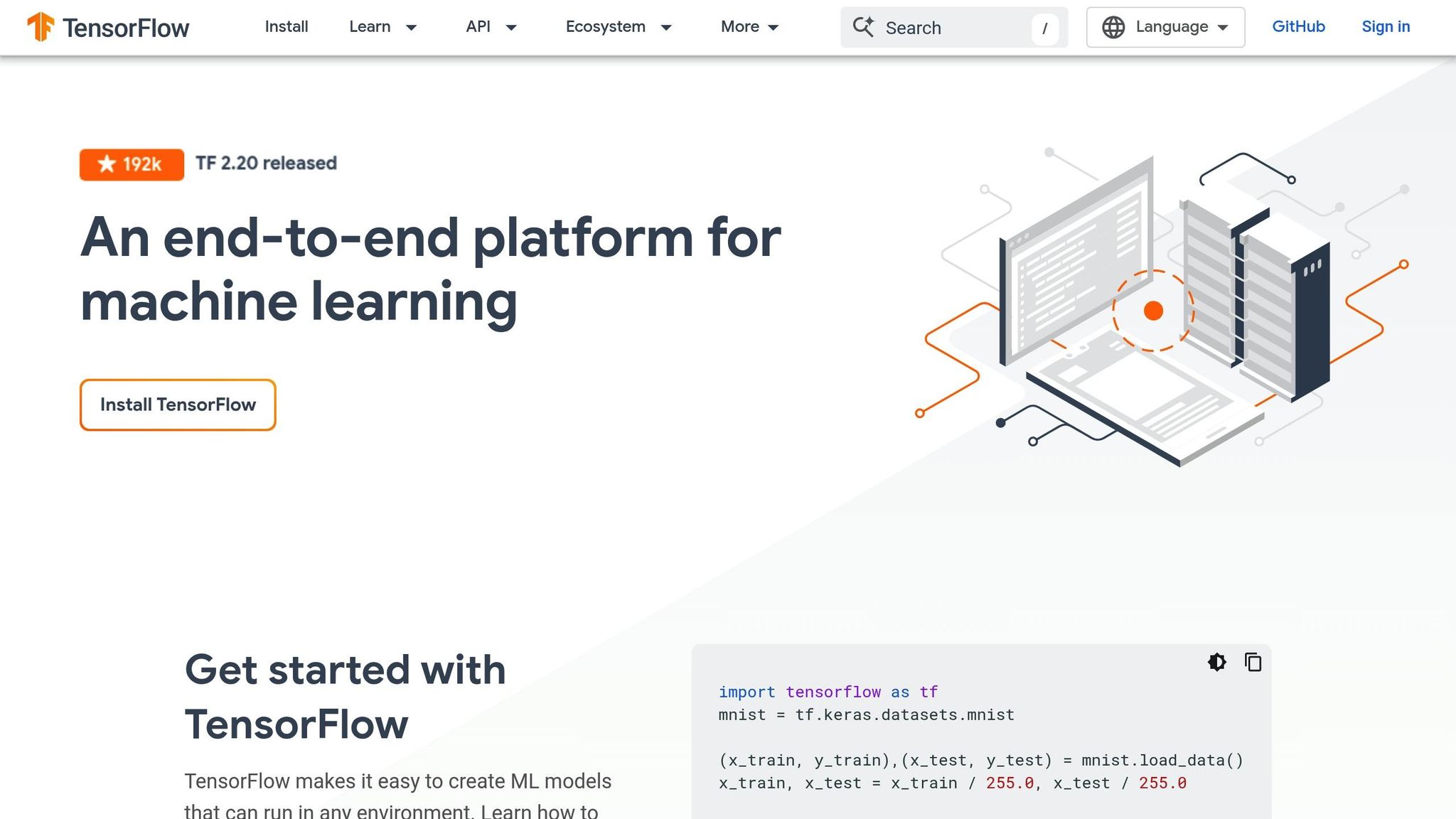
TensorFlow is an open-source framework from Google that gives users full control over building custom machine learning models, making it a powerful tool for advanced AI applications.
Key Features: TensorFlow shines in deep learning, neural network design, and cross-platform deployment. It caters to both experimental research and large-scale production needs. With TensorFlow Lite for mobile devices and TensorFlow.js for web-based applications, it offers flexibility across various environments.
Best For: Companies with dedicated data science teams aiming for specialized solutions. Industries like manufacturing (predictive maintenance), finance (fraud detection), and retail (personalized recommendations) often benefit from TensorFlow's capabilities.
Considerations: This tool demands significant technical expertise and time for development. Teams without prior machine learning experience may face a steep learning curve and need additional resources for implementation.
KNIME Analytics Platform
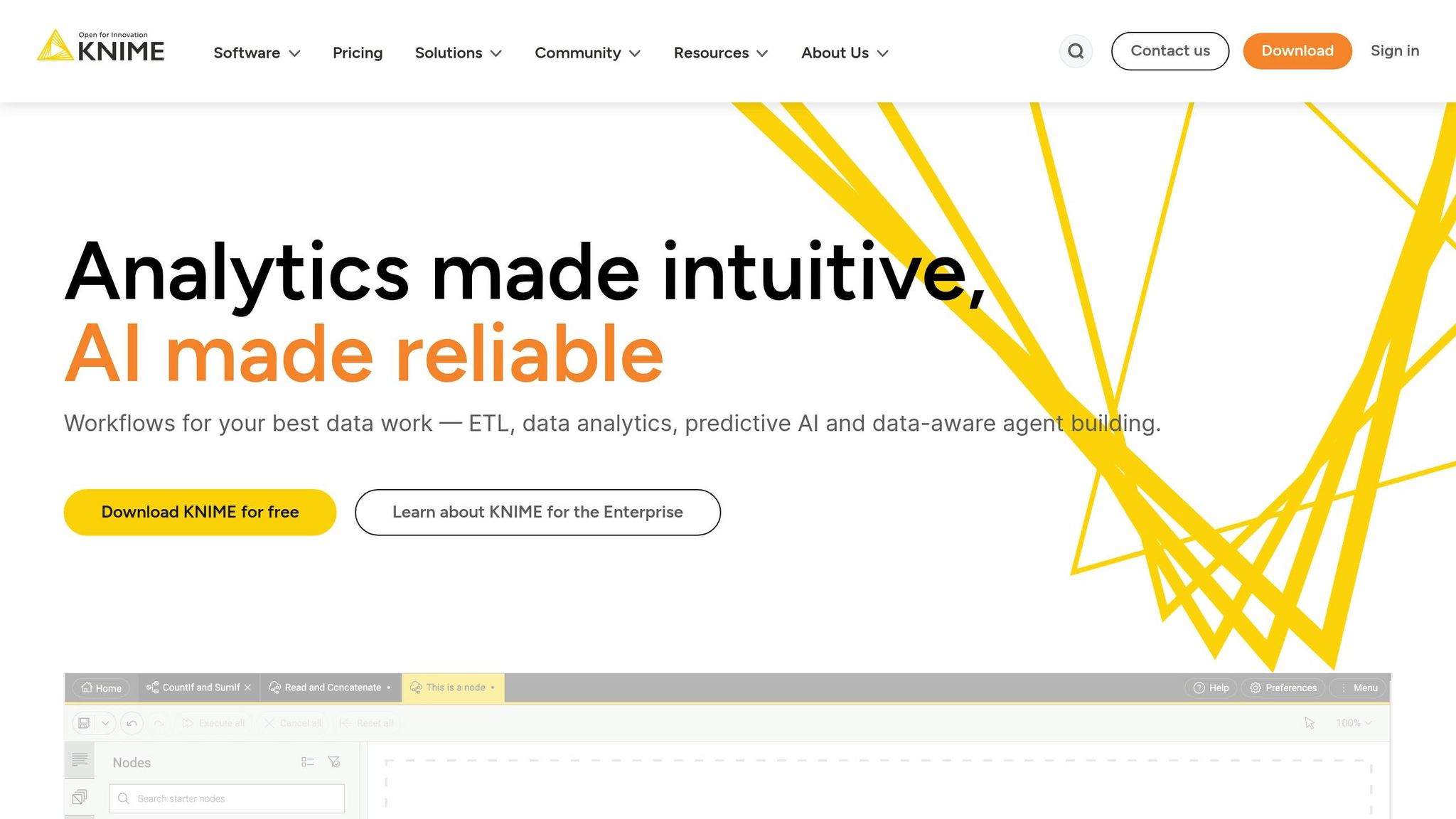
KNIME Analytics Platform bridges technical complexity and business usability with its visual workflow interface, allowing users to design AI processes using drag-and-drop components instead of coding.
Key Features: KNIME supports visual workflow design, integrates with numerous data sources, and includes pre-built machine learning tools. It also offers modules for text processing, image analysis, and time series forecasting, making AI accessible to non-technical users.
Best For: Mid-sized businesses that want AI capabilities without heavy programming requirements. Healthcare providers analyzing patient data, logistics teams optimizing supply chains, and marketers creating customer segmentation models often find KNIME useful.
Considerations: While user-friendly, KNIME still requires analytical skills and data science knowledge. Handling very large datasets may impact performance, and advanced customization might require some technical expertise.
DataRobot
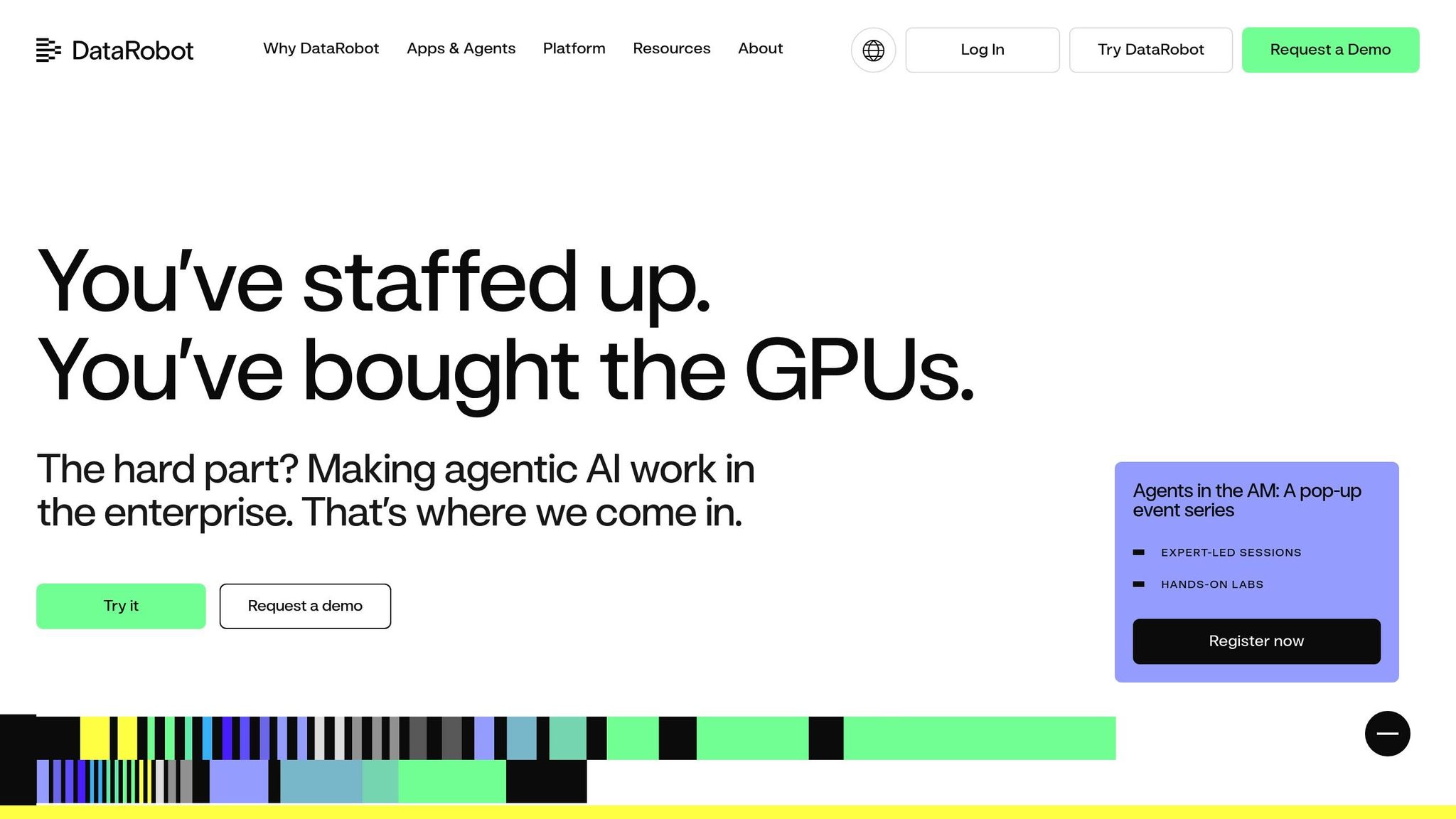
DataRobot simplifies the AI process by automating the entire machine learning pipeline, from data preparation to deployment, making it easier for businesses to implement AI solutions without deep technical expertise.
Key Features: This platform excels in automated machine learning (AutoML), model explainability, and deployment automation. It tests hundreds of algorithms, selects top performers, and explains how models make decisions. Features like built-in bias detection and model monitoring ensure reliable and ethical AI usage.
Best For: Businesses seeking fast AI results without building in-house data science teams. Industries like insurance (claims processing), banking (loan approvals), and retail (inventory management) see quick returns with DataRobot's automated approach.
Considerations: Its premium pricing may not suit smaller budgets. Additionally, organizations needing highly customized or novel AI solutions might find its automation limiting.
Google Vertex AI
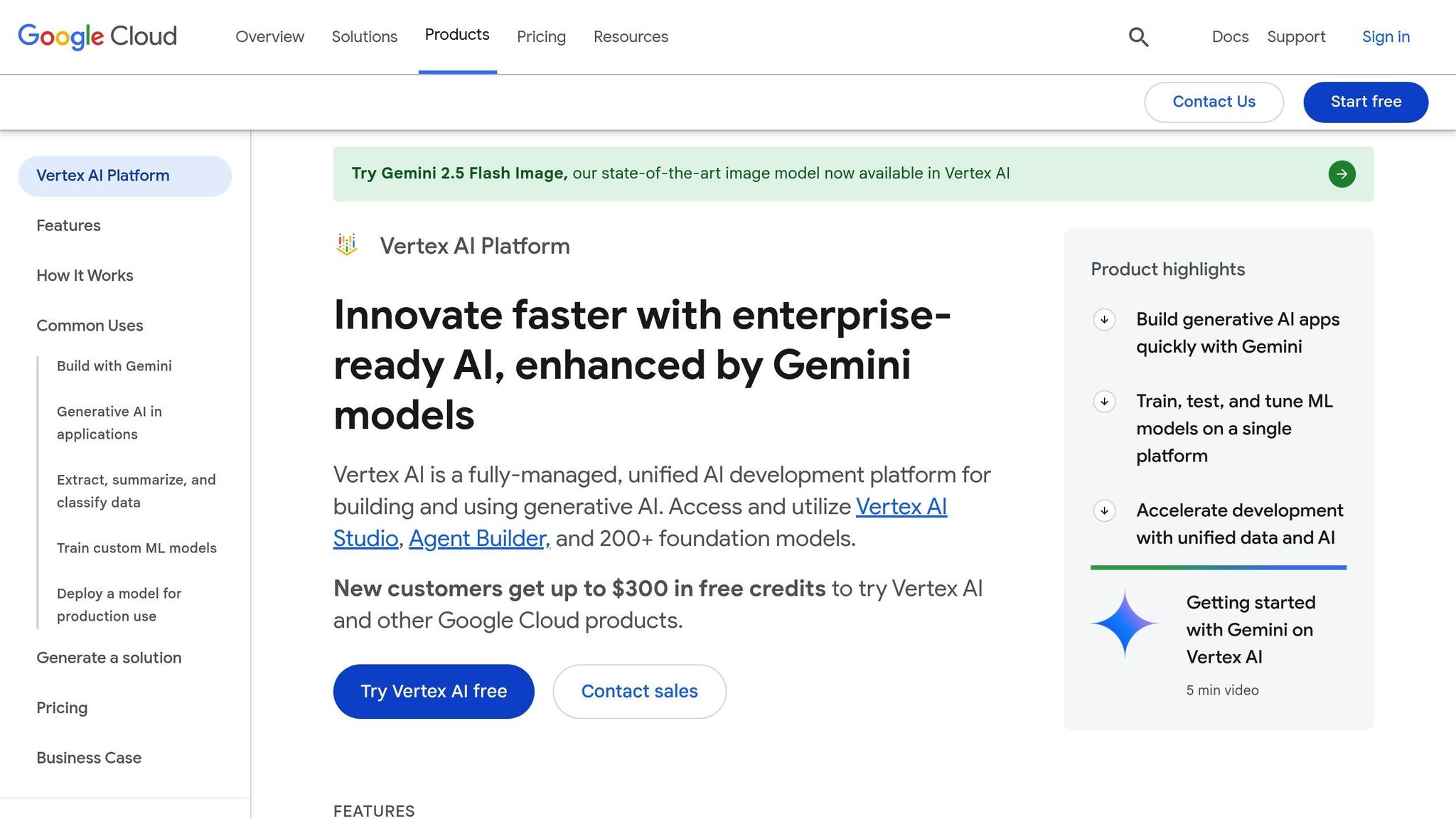
Google Vertex AI is a comprehensive machine learning platform that supports everything from data preparation to model monitoring, offering both automated and custom training options.
Key Features: Vertex AI integrates AutoML with custom training, MLOps tools for automation, model monitoring, workflow pipelines, version control through a model registry, and data management via a feature store. It also detects input drift and performance degradation automatically.
Best For: Enterprises already using Google Cloud or planning significant AI investments. It’s ideal for tasks like optimizing pricing strategies, improving diagnostic workflows, and enhancing supply chain operations.
Pricing: New users get up to $300 in free credits. Production workloads typically range from several hundred to thousands of dollars monthly.
Considerations: Vertex AI creates a dependency on Google Cloud infrastructure. Its complex pricing structure requires careful tracking to avoid unexpected costs.
H2O.ai
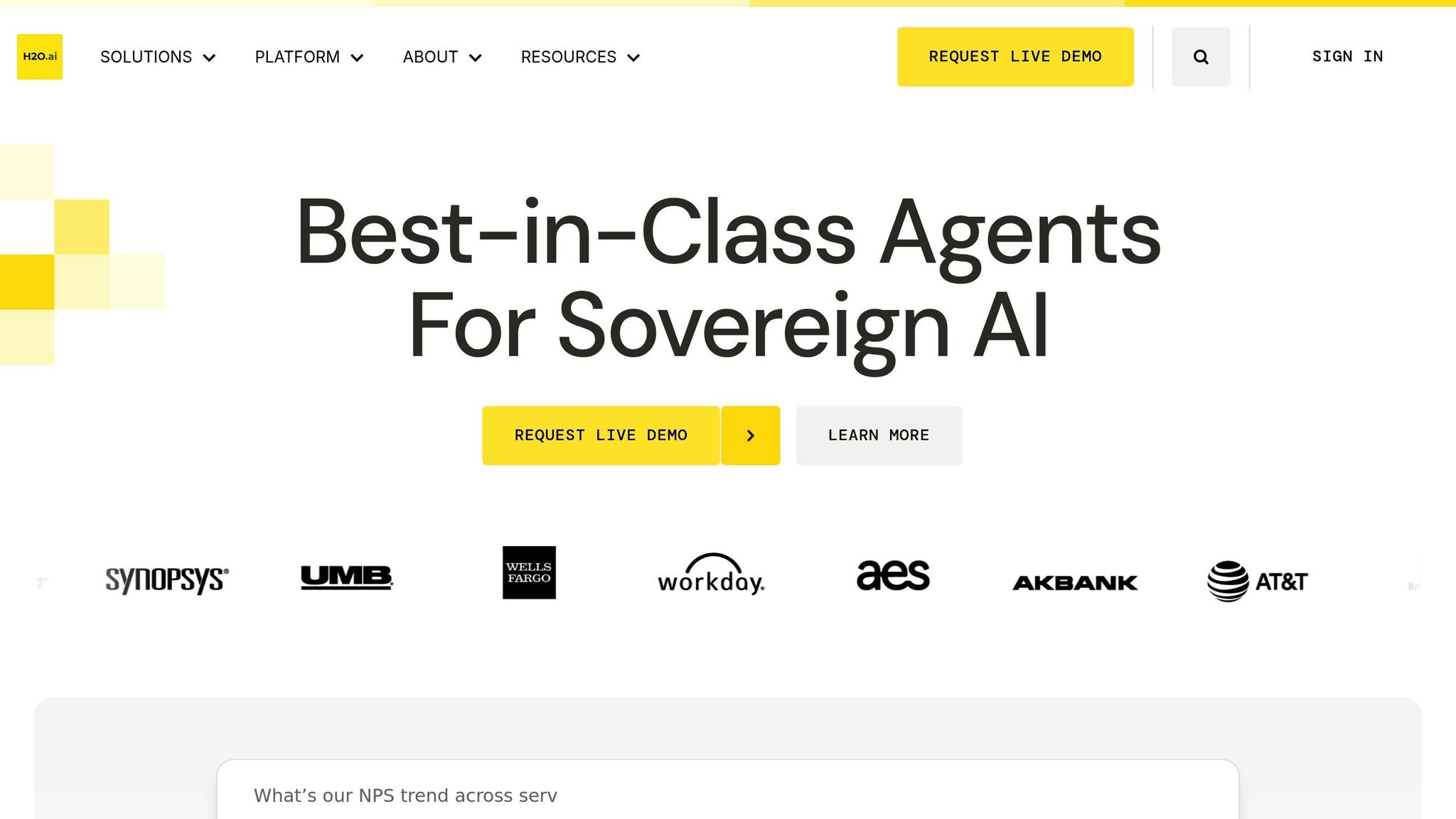
H2O.ai specializes in business optimization through its AI Cloud platform and the open-source H2O-3 framework, focusing on automated machine learning with an emphasis on transparency.
Key Features: H2O.ai covers the entire data science lifecycle, including feature engineering, model selection, and deployment. Its AI AppStore offers pre-built solutions for tasks like predictive maintenance and demand forecasting. The platform prioritizes model transparency, ensuring AI decisions are clear to stakeholders.
Best For: Businesses needing explainable AI for compliance or stakeholder trust. Financial institutions managing risk, manufacturers using predictive maintenance, and healthcare providers analyzing patient outcomes often turn to H2O.ai.
Pricing: H2O-3 is fully open-source, while H2O AI Cloud operates on an enterprise pricing model.
Considerations: While H2O-3 is free, enterprise features require significant investment. Organizations with some data science expertise will get the most out of the platform, as human oversight enhances its automation capabilities.
AI Tools Feature Comparison
When evaluating AI tools, it's essential to focus on features that align with your operational needs and long-term goals. Here are some key aspects to consider:
- Integration Capabilities: Look for AI tools that work effortlessly with your existing systems. Strong API support and flexible connectors ensure smooth data exchange and better workflow integration.
- Automation Features: Tools that automate entire workflows can significantly reduce manual tasks, saving time and improving overall efficiency.
- Scalability and Customization: Choose platforms that can grow with your business. Tools that allow for tailored adjustments to meet unique requirements will better support your expansion and ROI goals.
- Security and Compliance: Ensure the tool adheres to U.S. security standards like SOC 2 or ISO 27001. Features such as audit trails are crucial for meeting regulatory requirements.
- Transparent Pricing: Clear and straightforward pricing models make it easier to plan budgets and calculate ROI as your operations scale.
Implementation Best Practices
Implementing AI successfully goes beyond just picking the right tools. It requires careful preparation, engaging key stakeholders, and consistently monitoring performance to ensure everything runs smoothly.
Data and Process Preparation
AI systems are only as effective as the data they rely on. Before jumping into implementation, you need to focus on building a strong data foundation and understanding your current processes.
Start with a data audit: clean up duplicates, fill in missing values, and standardize formats. Consistency is key, so establish clear data governance rules to maintain quality over time.
Next, map your workflows. Document decision points, approval chains, and other critical steps in your processes. This gives you a clear picture of where AI can make the biggest impact while helping avoid disruptions to your core operations.
Once your data is clean and workflows are mapped, get your team on the same page to support the transition.
Stakeholder Alignment
One of the biggest hurdles in AI implementation is resistance from stakeholders. To overcome this, you need to build alignment across all departments by communicating the benefits, setting realistic expectations, and addressing concerns early on.
Start by identifying everyone involved - end users, IT teams, compliance officers, and leadership. Each group will have its own priorities, so tailor your communication to address their specific needs.
Having executive sponsorship is critical. Leaders need to actively support the initiative, allocate resources, and visibly back the project. Their involvement can help ease resistance and drive momentum across the organization.
A solid change management strategy is also essential. This includes training, transparent communication, and ongoing support to show employees how AI tools can enhance their roles rather than replace them.
To test the waters, launch pilot projects with early adopters. These smaller-scale rollouts help validate your approach and iron out any issues before a full deployment.
Monitoring and Improvement
AI systems require ongoing monitoring and refinement to maintain their effectiveness.
Set clear key performance indicators (KPIs) that align with your goals. Examples might include reducing processing times, lowering error rates, cutting costs, or improving customer satisfaction. Tracking these metrics against pre-AI benchmarks will show whether your implementation is delivering results.
Use real-time monitoring tools to catch performance issues or data quality problems as they arise. Since business needs evolve, keeping a close eye on your AI tools helps you adapt before issues escalate.
Create feedback loops between end users and your technical team. Regular check-ins and feedback sessions are invaluable for identifying areas where the system could improve and ensuring it continues to meet your needs.
Plan for ongoing improvements. Schedule regular reviews to assess how well your AI tools are performing and whether they still align with your business objectives. This might involve retraining models, tweaking parameters, or adding new data sources to keep the system effective as your organization grows.
Finally, document everything. A clear record of your processes makes troubleshooting easier, helps onboard new team members, and lays the groundwork for scaling AI across your organization.
For those looking to fast-track their AI journey, partnering with experts like NAITIVE AI Consulting Agency can provide the guidance needed to handle complex implementations and achieve the best outcomes.
Conclusion and Next Steps
AI-powered process optimization has transitioned from being a futuristic idea to an essential part of modern business operations. Today’s leading AI tools offer practical ways to streamline workflows, cut costs, and enhance efficiency across various functions.
The secret to achieving success with AI lies in selecting the right combination of tools that fit your business goals and technical setup. Whether it’s using KNIME Analytics Platform to automate data analysis or leveraging DataRobot for enterprise-scale solutions, each tool has specific strengths that can address unique challenges.
That said, the way you implement these tools is just as important as the tools themselves. To get the most out of AI, you need clean, well-organized data, clearly defined workflows, and support from key stakeholders. Without these foundational elements and consistent monitoring, even the most advanced AI systems will struggle to meet expectations.
AI implementation doesn’t have to be overwhelming. Working with experts can simplify the process, from choosing the right tools to ensuring smooth deployment. NAITIVE AI Consulting Agency specializes in creating autonomous AI solutions, from powerful automation systems to advanced voice agents, all designed to deliver measurable results.
What sets NAITIVE apart is their focus on outcomes. When you're ready to go beyond basic automation, their team brings the technical know-how and business insight needed to make a real impact.
Start by evaluating your current processes to identify areas where AI can make the biggest difference. Begin with small pilot projects, track measurable improvements, and then expand successful initiatives across your organization.
FAQs
How can I choose the right AI tool to optimize my organization's processes?
To choose the right AI tool for streamlining your operations, start by pinpointing your business's specific needs and objectives. Think about key factors like how well the tool can grow with your business, how easily it integrates with your existing systems, and the amount of technical know-how required to set it up and maintain it.
Next, dig into potential options by checking out customer reviews, real-world case studies, and the vendor's history of performance. Make sure the tool offers smooth integration features, such as APIs, to ensure a quick setup with minimal disruption to your workflow. By following these steps, you’ll be better equipped to select a solution that fits your company’s unique demands and long-term plans.
What should businesses consider when integrating AI tools into their existing systems and workflows?
When bringing AI tools into your existing systems, the first step is conducting a thorough workflow analysis. This helps identify the areas where AI can make the most impact and ensures the tools you choose align with your business goals. It's also crucial to confirm that these tools integrate smoothly with your current systems to avoid unnecessary disruptions.
Make sure to prioritize data quality - AI thrives on clean, well-organized data. At the same time, don't overlook security measures to safeguard sensitive information. Another key factor is ensuring the tools provide a smooth and intuitive user experience for your team, making adoption easier.
To minimize risks, start by testing the AI solution on a smaller scale before rolling it out fully. Keep a close eye on its performance and be ready to make adjustments. This approach helps ensure a smoother transition and sets the stage for long-term success.
What’s the best way to measure ROI from AI tools used for process optimization?
To gauge the return on investment (ROI) from AI tools, begin by pinpointing key performance indicators (KPIs). These might include metrics like cost savings, reduced time spent on tasks, revenue growth, or improvements in operations that are directly linked to your AI initiatives. Then, apply the standard ROI formula: (Benefits - Costs) ÷ Costs × 100 to determine the percentage return on your investment.
It's also important to monitor other metrics such as adoption rates, efficiency improvements, and risk reduction across various parts of your business. These data points provide valuable insights into the real-world impact of AI tools and help ensure your investment is aligned with your broader business objectives.




